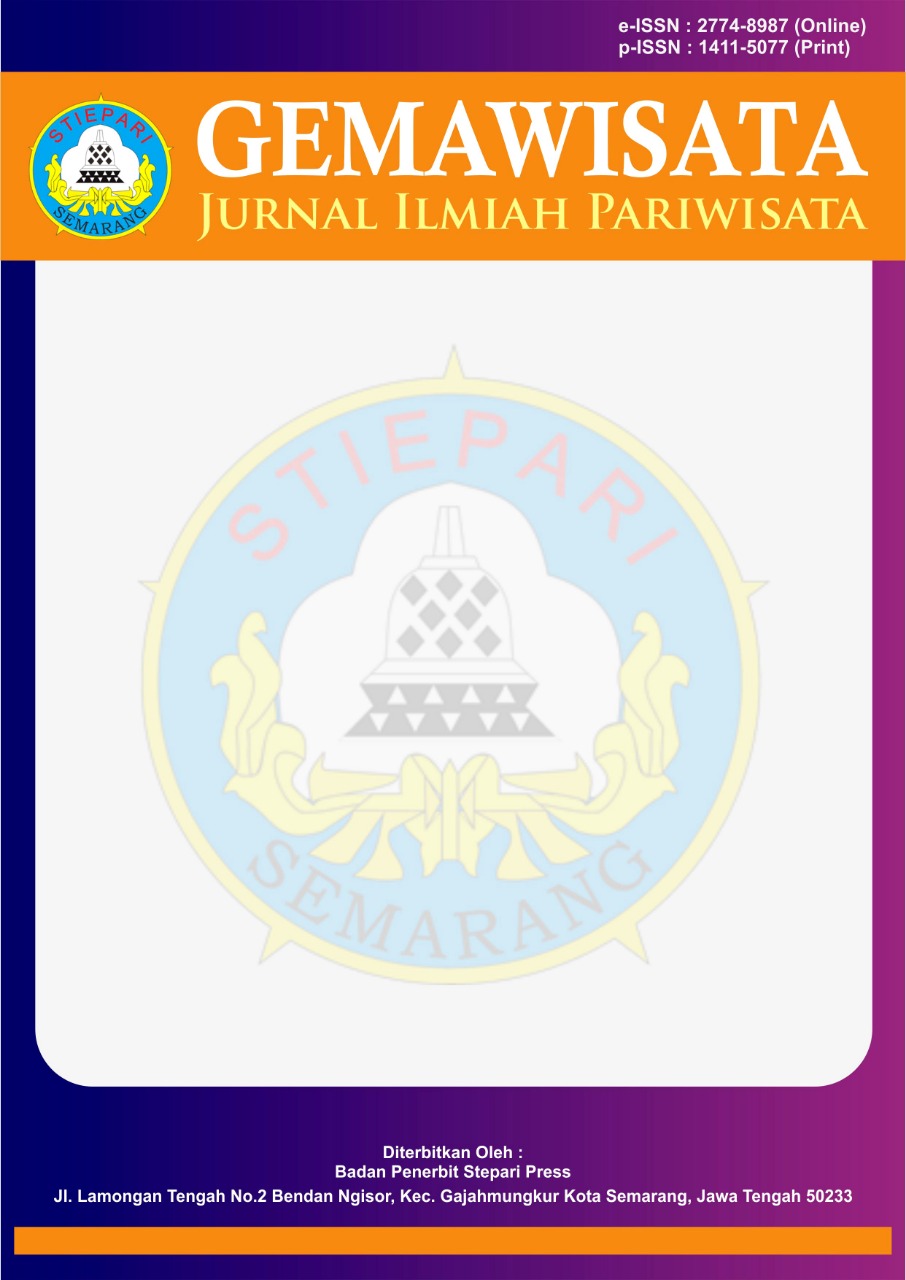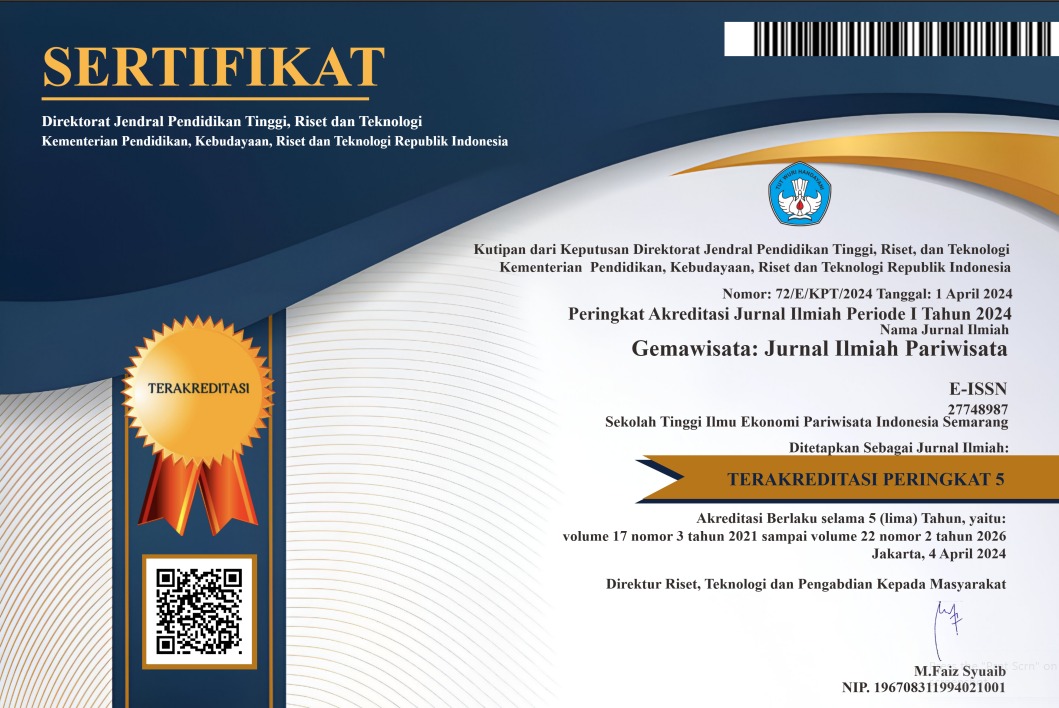Pengembangan Potensi Hutan Bambu sebagai Supporting Attraction di Desa Wisata Penglipuran, Bali
DOI:
https://doi.org/10.56910/gemawisata.v21i2.713Keywords:
Bamboo Forest, Supporting Attraction, Sustainable Tourism, Tourism VillageAbstract
Penglipuran Tourism Village, renowned for its cultural authenticity and environmental cleanliness, has experienced substantial growth in tourist arrivals, which has led to environmental pressures and overcrowding in its core area. In response, the development of the Bamboo Forest as a supporting attraction has emerged as a strategic initiative to disperse visitor concentration and promote sustainable tourism. This study aims to examine the development concept of the Bamboo Forest through a qualitative descriptive approach, employing in-depth interviews with local stakeholders, including tourism managers and community leaders. The findings reveal that the Bamboo Forest, spanning 45 hectares, serves multiple ecological and cultural functions, such as groundwater conservation, disaster mitigation, and the preservation of local traditions. Since 2023, the site has been revitalized with ecotourism-based infrastructure, including bamboo pathways, cultural performance spaces, a traditional market, and the Bamboo Caffe, all of which integrate local resources and community participation. Development efforts are aligned with key tourism components: attraction, accessibility, amenities, and ancillary services, while adhering to sustainable tourism principles: something to see, something to do, and something to buy. The project has not only enhanced the visitor experience but also generated significant economic benefits, contributing to community welfare. Overall, the integration of environmental, economic, and socio-cultural aspects in the Bamboo Forest development exemplifies a holistic approach to sustainable tourism in rural destinations.
References
Amir, H., Kusuma, W. A., & Nurhidayati, S. (2024). Ecotourism experiences and revisit intention: The role of visual and emotional engagement. EcoHumanism Journal, 4(1), 31–45.
Cooper, C., Fletcher, J., Gilbert, D., & Wanhill, S. (1994). Tourism: Principles and practice. London: Pitman Publishing.
Febriandhika, I., & Kurniawan, T. (2019). Membingkai konsep pariwisata yang berkelanjutan melalui community-based tourism: Sebuah review literatur. JPSI (Journal of Public Sector Innovations), 3(2), 50–56.
Herdiana, D. (2019). Peran masyarakat dalam pengembangan desa wisata berbasis masyarakat. Jurnal Master Pariwisata (JUMPA), 6(1), 63–86.
Junaid, I., Dewi, W. O., Said, A., & Hanafi, H. (2022). Pengembangan desa wisata berkelanjutan: Studi kasus di Desa Paccekke, Kabupaten Barru, Indonesia. Journal of Regional and Rural Development Planning (Jurnal Perencanaan Pembangunan Wilayah dan Perdesaan), 6(3), 287–301.
Korten, D. (1987). Community management. New Delhi: Kumarian Press.
Mumtaz, A. T., & Karmilah, M. (2021). Digitalisasi wisata di desa wisata. Jurnal Kajian Ruang, 1(1), 1–15.
Rahayu, M. L. S., Riyanto, W. H., & Syaifullah, Y. (2020). Strategi pengembangan ekowisata di Hutan Bambu Kabupaten Lumajang. Jurnal Ilmu Ekonomi JIE, 4(1), 70–81.
Sitompul, M. S. (2024). Pengembangan daya tarik ekowisata berbasis potensi visual dan edukatif di kawasan konservasi Sumatera Utara. Jurnal Penelitian Pendidikan IPA (JPPIPA), 10(2), 215–225.
Suharyono, S., Aipassa, M. I., Bulan, D. E., Karyati, K., Rayadin, Y., Siahaya, M. E., ... & Kristiningrum, R. (2023). Strategi pengembangan ekowisata hutan mangrove PT Inhutani I Unit Batu Ampar-Mentawir Kelurahan Mentawir Kecamatan Sepaku Kabupaten Penajam Paser Utara. AGRIFOR, 22(2), 283–296.
Wang, L., Zhang, H., & Liu, Y. (2023). Destination image, tourist motivation and responsible behavior in ecotourism: A structural model analysis. Journal of Hospitality and Tourism Management, 56, 67–76.
Yoeti, O. A. (1983). Pengantar ilmu pariwisata. Bandung: Angkasa.


1_(1).jpg)






